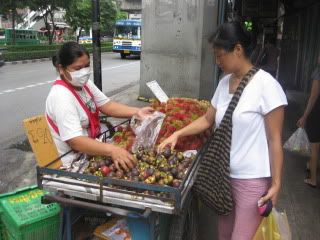
Rambutan, which I never had an opportunity to try, but I photographed on numerous occasions.
Folks keep asking me to expand on what I ate while I was in Thailand.
Lots and lots and lots of fruit. Most any fruit in season can be purchased on the street by the bag (plastic of course), already cut and ready to eat with a wooden skewer, for less than a dollar. A whole pineapple, sweeter than I’d ever tasted, cut into bite-sized bits or a mango (mostly green mango right now, which has a crunchy dry flesh and tart flavor) or papaya, would get us through the morning or afternoon until our next proper meal.
Whatever it is about that climate, the hot humidity seems to foster a orgy of super-sweet fruits, many of which were in season while I was there – since August is the beginning of the rainy season, and many of which I’ve never seen or even heard of here in the States.

Sue buying mankoot from her favorite fruit vendor on the soi.
It did seem to be the end of mankoot (also known as mangosteen) season, but there were still enough around at the beginning of my visit to get my fill of the very sweet grape-like sections of my favorite fruit. The other fruit I missed was noi naa, a CREAMY custard apple, for which my niece was nick-named. Apparently it came into season the day after I left town.
Even after experiencing durian, I cannot envision what a noi naa might taste like. The outside is like a knobby green apple and about the same size. But Sue was adament about eating fruit in season, and there were so many in season, that I’m not really complaining – just explaining.

Joss and Noi naa by a longon and durian cart.
Durian is among one of the most bizarre things I’ve eaten. The outside of the durian is formidable and intimating: the size of a watermelon but with a thick spiky brown-green rind and these things grow on trees and hang overhead! Very little of this fruit is eaten: the vendors cut open the rind and pry out yam-sized white things that look like, I hate to say this, pig fetuses, from the center. Sometimes there are several of these “centers” in a single durian. The rest, the rind, and all the white enveloping fiber is tossed aside.
The “centers” are creamy. Yes, creamy. And sweet, almost like a carmelized onion. They are very filling, and eating one is similar to eating a roasted yam (which is another popular street food).
The thing that durian is infamous for though, is its odor. Within just a few hours up being cut open (freshness is critical when eating durian), the durian begins to emit an overpowering sickly sweet stench that is universally despised. Think the word “universal” is too strong? There are signs on the subway and in taxis forbidding passengers to carry durian on board, right next to No Smoking and No Sex.

"No Durian" is sixth from the left.
Further, I was first introduced to durian at Not-Back-To-School Camp many years ago, by a satirical song and skit done by two campers, revering the offputting smell of durian and climaxing in a challenge to the whole of camp to eat a piece. (Although, in retrospect, I wonder if they knew how to eat durian?)
And lastly, even my sister strictly forbids the eating of durian in her house (so I had to do it while she was in South Africa…)

Vendors use box-cutters to slice into sala, and the rind comes off in a single diagonal spiky strip.
She does allow sala, which she dropped in front of me with an admonition not to mind the smell. Sala was not so sweet, but slightly tart and acidic. The flavor was strong and very addictive, but it was best eating slowly while chatting. For some reason it reminded me of the peanuts one might eat while drinking beer – maybe because I felt like sala should accompany something to cut its bite – but I never found its perfect pair.

Me and Christian with pomelo, one of our everyday favorites.
Three things we ate on near daily basis were pomelo, longon, and dragon fruit. Pomelo appears to be closely related to grapefruit, but with much larger pulp. Its flavor was mild and it was easy to demolish tray after tray. This was a fruit we always got already peeled – the vendors painstakingly got rid of all the rind, white (I know the white has a name, but what is it??), and veins – leaving only delicious, refreshing pulp.

Longons were in peak season and were always on the table for snacking.
Longons took me a few days to appreciate. Each ping-pong ball-sized longon is peeled individually to reveal something that looks a bulb of garlic, but with the texture and flavor of a grape.

Dragon fruit comes with white or red flesh. The red variety looks wilder and turns your pee pink and your poo unspeakable purple.
The kids loved dragon fruit and so we would cut one almost everyday. The flesh was unusually beautiful and exotic as it was flecked with small black seeds. The seeds were easy to eat, with about as much crunch as a strawberry seed; they also created a healthy mucous-y gel, like flax, in the belly, which I think was very healthy for our guts. We could always tell when the kids had been eating dragon fruit, because their poop would come out speckled with the same black seeds.
Wish I had some now.
